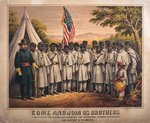SPANISH FORT — The hot rounds of enemy gunfire flew over their heads as they hurriedly split the earth in two to find safety in the clay and dirt.In those hastily dug trenches, men who had been …
This item is available in full to subscribers.
Please log in to continue |


SPANISH FORT — The hot rounds of enemy gunfire flew over their heads as they hurriedly split the earth in two to find safety in the clay and dirt.
In those hastily dug trenches, men who had been slaves stood their ground. And it was here where they stepped out of the shadows and made the last charge of the Civil War.
Historians knew the trenches where United States Colored Troops (USCT) dug in while taking heavy fire from Confederate forces were on property owned by the historic Blakeley Foundation. They also knew neither they, not visitors, could easily access those places.
The area was north of the entrance to Historic Blakeley State Park, far from any trails or access point. In the years since the battle unfolded on April 9, 1865, those earthworks they dug and the paths they forged were swallowed whole by the forest.
Last week, visitors stepped onto that ground for the first time in over 150 years thanks to a grant from Impact 100 Baldwin County.
Mike Bunn, director of Historic Blakeley State Park, said the first step in bringing visitors was to map trails beneath the tangle of underbrush and weeds and show investors the story that those places told.
"I don't think most people realize, about quarter of the federal forces that assaulted Fort Blakely on April 9 were United States Colored Troops (USCT) and overwhelmingly those guys were former slaves who volunteered to fight in the federal army," Bunn said.
He added that the contingency of African American soldiers at Blakeley is one of the largest of the Civil War.
"We thought this was a significant story and adds a lot to people's understanding of the significance of this battle," he said.
The Historic Blakeley Foundation received $90,000 in 2021 from Impact 100 to complete several projects around the park, including giving visitors access to the USCT trail. The grant was also used to restore, preserve, reconstruct and rehabilitate the Blakeley town site, surrounding sites of the Battle of Fort Blakeley, the nearby Indian mounds.
The new trail allows visitors to track the movement of the USCT as they advanced to the Confederate lines while under fire. Signs point out the first, second and third trenches that the men dug, and an audio tour gives visitors a full description of the action that took place here. At the third parallel, the closest line the Federals drew to their enemy, the soldiers launched the assault of Fort Blakeley.
You can see the very spot where they stepped out of the trenches and began the siege.
Unlike the open field at Redoubt 4 where the re-enactment of the April 4 battle takes place every few years, the forest still hovers around the trenches of the USCT and weeds continue to fight to take over the freshly revealed lines.
Bunn said someday he hopes to have a walking or bike trail that links the trenches to the rest of the park but waiting until that project was funded and installed was simply too long.
The USCT's story, he said, needed to be told.
"There is no more powerful experience than to stand in front of an earthwork you know somebody dug while under fire over 150 years ago," Bunn said. "That is a powerful connection to history, and we want to share it with people."